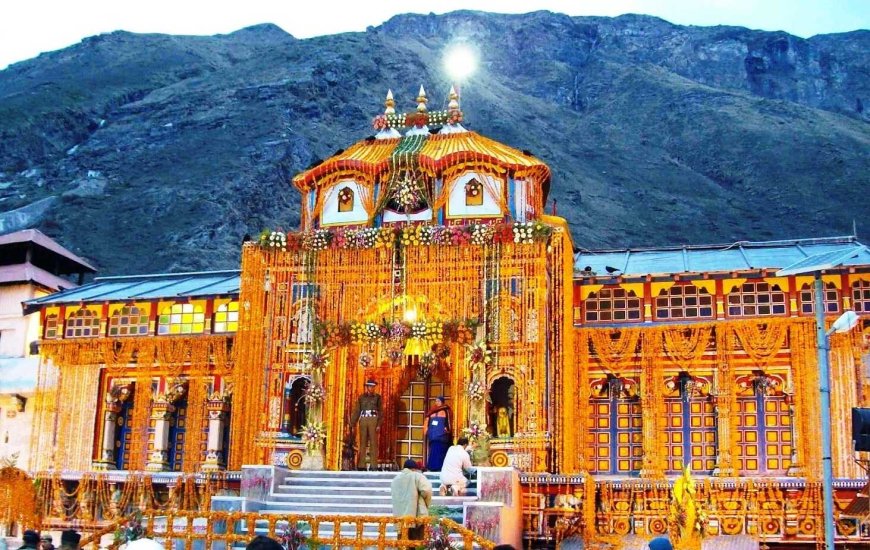Badrinath Yatra
Badrinath is a holy town located in the Chamoli district of Uttarakhand, India. It is one of the four Char Dham pilgrimage sites in Hinduism, and is situated at an elevation of 3,133 meters above sea level, on the banks of the Alaknanda River.
Badrinath is one of the most revered pilgrimage sites in India, attracting thousands of devotees and tourists each year. Here are some key facts about Badrinath and why people visit this sacred place to worship Lord Vishnu:
-
Spiritual Significance:
- Char Dham: Badrinath is one of the four Char Dham pilgrimage sites in India, which also include Kedarnath, Gangotri, and Yamunotri. These sites are highly revered in Hinduism.
- Lord Vishnu: The main deity of the Badrinath temple is Lord Vishnu, worshipped here in the form of Badrinarayan. According to Hindu mythology, Badrinath is where Lord Vishnu meditated under the Badri tree for thousands of years.
-
Mythological Importance:
- Adi Shankaracharya: The temple's prominence was revived by the 8th-century philosopher and theologian Adi Shankaracharya, who established a shrine here and appointed priests to maintain the traditions and rituals.
- Nar-Narayan: It is believed that the twin peaks of Nar and Narayan form the backdrop of the temple, symbolizing the two forms of the divine that performed penance here.
-
Geographical Location:
- Himalayan Beauty: Located at an altitude of 3,300 meters (10,827 feet) in the Garhwal Himalayas, Badrinath is set against the stunning backdrop of the Neelkanth peak.
- Alaknanda River: The temple is situated on the banks of the Alaknanda River, which adds to the serene and sacred ambiance of the area.
-
Pilgrimage Practices:
- Opening and Closing: The temple is open for six months a year, typically from April to November, due to the harsh winter conditions. The opening date is fixed on the auspicious occasion of Akshaya Tritiya, and the closing date is on Vijayadashami.
- Festivals and Rituals: Various festivals, especially Badri-Kedar Utsav, and rituals like the Maha Abhishek, are observed with great fervor.
-
Legends and Stories:
- Badri Vishal: One legend states that Lord Vishnu did severe penance here, and Goddess Lakshmi, in the form of a Badri tree, provided him shelter from the harsh weather.
- Pandavas: Another legend connects the Pandavas from the Mahabharata to Badrinath, stating that they crossed through this region during their journey to heaven.
-
Architectural Marvel:
- Temple Structure: The temple, built in a traditional North Indian style, features a tall conical structure with a small cupola on top, covered with a gold gilt roof. The facade is made of stone, and the main shrine houses the black stone statue of Badrinarayan.
-
Accessibility:
- Tough Journey: The journey to Badrinath is considered challenging but rewarding. Pilgrims often travel long distances on foot, braving difficult terrain and weather conditions to seek blessings.
-
Cultural and Religious Hub:
- Sacred Baths: Pilgrims often take a dip in the Tapt Kund, a natural hot water spring, before entering the temple, as it is believed to cleanse the body and soul.
- Spiritual Retreat: The area around Badrinath is also known for its ashrams and places where sages and saints meditate, making it a spiritual retreat.
These elements collectively make Badrinath a significant destination for Hindu pilgrims and a place of great cultural and spiritual importance.
Reaching Badrinath from Dehradun and Haridwar involves a combination of road and possibly rail transport. Here's a detailed guide on how to make the journey from each city:
From Dehradun to Badrinath
By Road:
- Taxi or Car: You can hire a taxi or drive your own car. The distance from Dehradun to Badrinath is approximately 335 kilometers and takes around 10-12 hours, depending on road conditions.
- Route: Dehradun → Rishikesh → Devprayag → Srinagar (Uttarakhand) → Rudraprayag → Karnaprayag → Nandaprayag → Chamoli → Joshimath → Badrinath.
- Bus: Uttarakhand Transport Corporation (UTC) operates buses from Dehradun to Badrinath. However, direct buses are limited, and you may need to change buses at certain points like Rishikesh or Joshimath.
By Train:
- Train to Haridwar/Rishikesh: Take a train from Dehradun to Haridwar or Rishikesh, and then follow the road journey as described below from Haridwar/Rishikesh to Badrinath.
By Air:
- Helicopter Service: Helicopter services are available from the Sahastradhara helipad in Dehradun to Badrinath. This service is more expensive but significantly reduces travel time.
From Haridwar to Badrinath
By Road:
-
Taxi or Car: You can hire a taxi or drive your own car. The distance from Haridwar to Badrinath is approximately 315 kilometers and takes around 10-11 hours.
- Route: Haridwar → Rishikesh → Devprayag → Srinagar (Uttarakhand) → Rudraprayag → Karnaprayag → Nandaprayag → Chamoli → Joshimath → Badrinath.
-
Bus: Direct buses to Badrinath are available from Haridwar, operated by the Uttarakhand Transport Corporation (UTC). It's advisable to book your tickets in advance during the peak pilgrimage season.
By Train:
- Train to Rishikesh: Take a train to Rishikesh and then continue by road from Rishikesh to Badrinath. This leg of the journey is similar to the road trip described above.
General Tips for Both Journeys:
- Weather and Road Conditions: Check weather and road conditions before starting your journey. Landslides and roadblocks are common, especially during the monsoon season.
- Accommodation: Consider booking accommodation in advance in Joshimath or Badrinath, especially during peak pilgrimage season.
- Health Precautions: The altitude and long journey can be taxing. Ensure you are adequately prepared for high altitudes and carry necessary medications.
- Permits: Sometimes, special permits may be required, especially for foreign tourists. Check in advance.
- Safety: Drive cautiously as the roads are mountainous and can be challenging. It’s often recommended to have an experienced driver for the journey.
Important Stops En Route:
- Rishikesh: Known as the Yoga Capital of the World, it's a good stop for a spiritual experience and rest before continuing your journey.
- Devprayag: The confluence of the Alaknanda and Bhagirathi rivers, forming the Ganges, is a sacred spot.
- Joshimath: A key stop before the final ascent to Badrinath, where you can rest and acclimatize.
Planning your trip with these details will help ensure a smooth and spiritually fulfilling journey to Badrinath.
What's Your Reaction?





























































